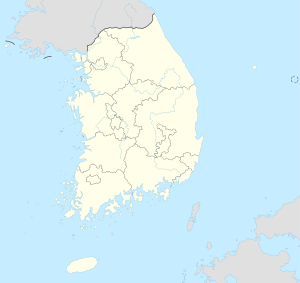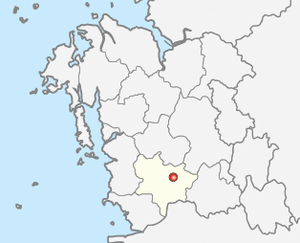Buyeo gun
| Buyeo gun | |||
|---|---|---|---|
| Korean alphabet : | 부여군 | ||
| Chinese characters : | 扶餘 郡 | ||
| Revised Romanization : | Buyeo gun | ||
| McCune-Reischauer : | Puyŏ-gun | ||
| Basic data | |||
| Province : | Chungcheongnam-do | ||
| Coordinates : | 36 ° 17 ′ N , 126 ° 55 ′ E | ||
| Surface: | 624.6 km² | ||
| Residents: | 71,809 (as of November 2014) | ||
| Population density : | 115 inhabitants per km² | ||
| Structure: | Gun, Eup, 15 Myeons | ||
| map | |||
|
|||
Buyeo-gun ( 부여군 ) is a district with a population of almost 72,000 in Chungcheongnam-do Province ( 충청남도 ) in the west of South Korea . The small town of Buyeo-eup is the economic and administrative center of the district.
geography
Buyeo-gun is 33 km east of the west coast and 43 km west of the city of Daejeon ( 대전 광역시 ). The Geumgang ( 금강 ) flows through the district. Coming from the northeast, it flows around the city of Buyeo-eup in a semicircle, then meanders to the south and then to the southwest towards the Yellow Sea .
In terms of transport, Buyeo-gun is connected via various federal highways running in an east-west direction, which connect the city to the west with Expressway 151 and to the east with Expressway 25 . The city and the district do not have a direct train connection and goods transport by ship on the Geumgang is also not possible.
history
In AD 538, King Seong ( 성왕 ), 26th ruler of the Baekje Kingdom ( 백제 ), moved his capital and thus the seat of government and the royal palace from Ungjin ( 웅진 ), today's Gongju ( 공주시 ), to Sabi ( 사비 ), today's Buyeo. Sabi quickly developed into a center for art and culture, from which impulses went beyond the imperial borders. Significant at that time was u. a. Sabi's pottery and temple building. It is now believed that Sabi's religious and cultural influence extended as far as Japan.
After the lost battles against the armies of the Silla Kingdom and those of the Chinese Tang Dynasty in 660 AD and the associated fall of the Kingdom of Baekje, Sabi lost after 123 years of political and cultural focus under the rule of the United Silla its meaning.
When Sabi was renamed to Buyeo cannot be named exactly. In the Goryeo empire (918-1392) Buyeo was already known and the area of today's district was divided into four Hyeon administrative units, one of which was Buyeo. After a further reorganization during the Joseon period (1392-1897) into a gun and three Hyeons, a reorganization took place on March 1, 1914 under the Japanese occupation and their colonial government and Buyeo became a Gun (district) with 16 Myeons (rural communities) . On January 1, 1960, Buyeo was upgraded to a Eup (small town) and remained with the 15 remaining Myeons (rural communities) at the same time as a Gun (district).
Attractions
- The Archaeological Site of Gwanbuk-ri ,
- the Busosanseong Fortress ,
- the temple complex of Jeongnimsa ,
- the royal tombs of Neungsan-ri ,
- the city wall of Naseong ,
all registered as World Heritage Sites by UNESCO on July 4, 2015 .
Additionally there is
- the Buyeo National Museum,
- the Goran Temple,
- the Gwangchok Temple,
to visit.
See also
Web links
- Homepage of Buyeo-gun County and Buyeo-eup City. Buyeogun,accessed September 28, 2015(Korean).
Individual evidence
- ↑ Natural Environment . Buyeo-gun , accessed September 28, 2015 .
- ↑ a b History . Buyeo-gun , accessed September 28, 2015 .
- ↑ a b Klaus A. Dietsch: Gongju . In: South Korea . 1st edition. Trescher Verlag, Berlin 2013, ISBN 978-3-89794-244-8 , Central Korea, p. 274-277 .
- ^ In the Heart of Baekje Buyeo, the Last Capital of a Mighty Nation . In: Visit Korea . Korea Tourism Organization , accessed September 28, 2015 .
- ↑ Baekje historic areas to be listed on UNESCO World Heritage list . In: Visit Korea . Korea Tourism Organization , 2015, accessed September 12, 2015 .
- ↑ Homepage . Buyeo National Museum , accessed September 28, 2015 .

